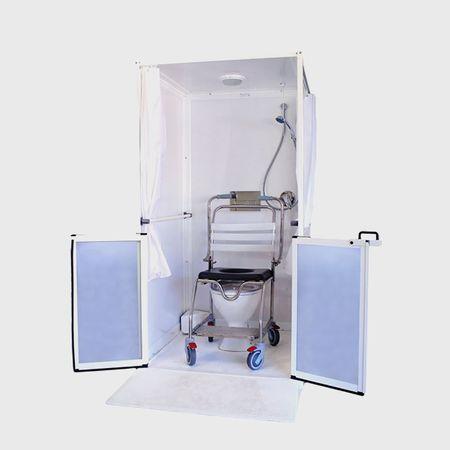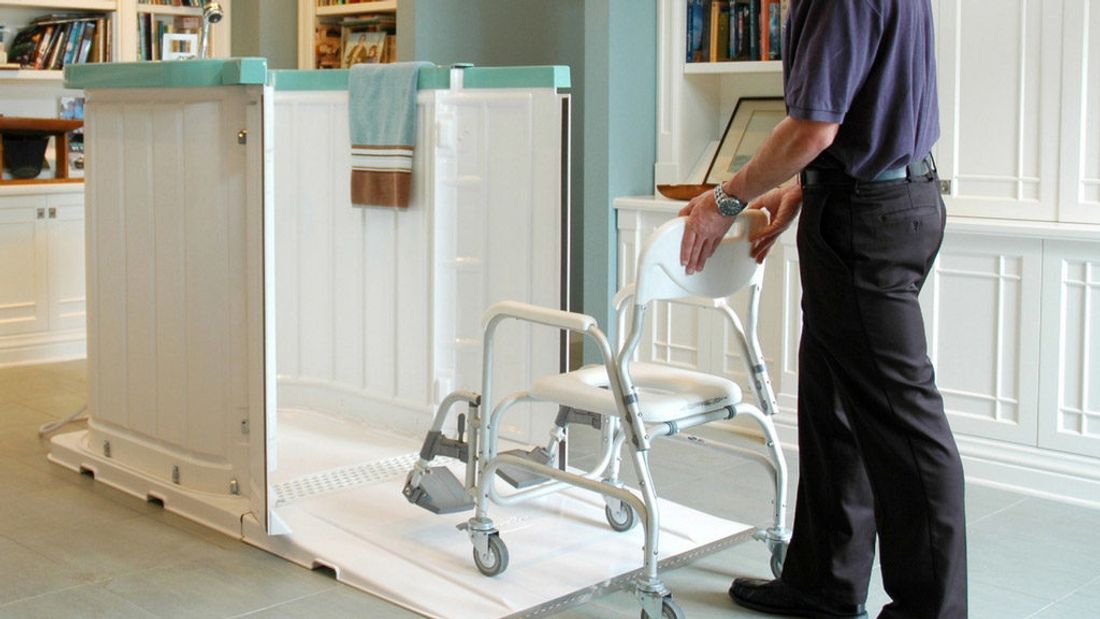I woke up this morning and as usual went off for my refreshing, morning shower. As the lukewarm water woke me up gently, my thoughts turned to a time when I was hospitalized, spending many days in bed. The nearest thing to a shower was a quick wipe with something I couldn’t see but didn’t feel all that pleasant.
My next thoughts were for a fellow professional who had the misfortune of a wall collapsing on top of him whilst working and who had lost the use of his legs and another guy I once knew who had fallen off a ladder and become paraplegic.
In my capacity as a surveyor, I designed the remodelling of the latter man’s house. It was the first project of that nature I had undertaken and very sobering at the same time as being challenging.
My mother is also aging gracefully but has the use of all her faculties and a stair lift to help her up to the upstairs bathrooms. At 96 she is doing well but I wished she had bought a bungalow so that everything was at one level. Anyway those showering thoughts this morning led me to researching for this article. So ….
Table of Contents
What is the Best Portable Shower for the Elderly or Disabled
The best portable shower for the Elderly or Disabled will depend on how portable it needs to be, whether it will be packed up after each use, needs to be moved assembled or whether it is a semi-portable showering solution. Some units are fabric/plastic flimsy affairs that can be packed away each use, some need simple assembly and others are altogether more solid units that are intended to stay in place for a period.
There you have it in brief but you will be needing a lot more information to help you decide which type of unit you need and the differences between them, as everyone’s situation differs.
My research led me to the realization that there is a huge amount of information on remodelling shower rooms for the average people who have the luxury of bathrooms and shower rooms they can enjoy. There’s also a fair bit of information for people who have mobility problems but can still care for themselves. There’s not so much around for people who cannot move around to the point where using the bathroom or a regular shower is no longer possible.
Who Needs a Portable Shower at Home?
It might not be obvious but there are quite a lot of different reasons that a portable shower would be something you need at home at least temporarily.
- People who are wheelchair bound or cannot use the bathroom either because they cannot get to it or because they can no longer manage using it.
- People who have a bathtub but can no longer safely and confidently use it
- People who cannot get out of the house but need to remodel their shower or bathroom
- People who need carer assistance to shower where the carer is outside the shower
- Families who receive elderly or infirm family members in their homes which are not equipped to enable them to shower
- Families who holiday with family members who are unable to use regular hotel bathrooms

How Does a Portable Shower Work?
A portable shower works by providing a dismountable enclosure supplied by water, usually from a tap or sink faucet nearby, to a handheld showerhead. The wastewater is handled by drainage through a pipe similar to a hosepipe and pumped away via a small pump into a nearby drain.
A portable shower needs to be – well – portable. But that is not the end of the story as there are varying degrees of portability.
To be truly portable it would need to be able to be easily packed away for storage in between uses. That means very minimal assembly and most of this type of portable shower unit are made with flexible waterproof materials. As with all things the quality of the unit will be determined by the quality of the materials, it is made from – and these can be quite expensive as they need to cope with being walked upon or wheeled over as well as stay waterproof and easily accessible.
I am sure you can imagine, in its simplest form a portable shower will need a floor to catch and drain the water, sides to provide privacy but with the ability to allow access to carers to help if necessary. They will also need a means of disposing of the water and providing the water to shower with at an acceptable temperature.
Where can I Set Up a Portable Shower?
The whole idea of a portable shower is that they can be set up almost anywhere. You don’t need a tiled floor, you don’t need a separate room, they can be assembled on carpets and in any room. They do need access to water and drainage though.
Apart from semi-permanent solutions, they will all need access to a drain of some sort, be that a floor drain or sink, to drain off the water.
Likewise, they are going to need to be somewhat near a water supply from a tap or possibly a tank that is filled for the purpose.
That is a problem as it means whichever type you buy will require setting up in a place that has both a water supply and a drain fairly close by. Most units rely on the heated house water supply pressure to get the water out of the shower head. This is not a great idea for you if the water supply is some distance away from the shower head. You’ll immediately realize that if the water is too hot or cold you’ll need to leave the shower compartment to adjust the temperature. And unless you are planning to exercise during the process, walking back and forth between the tap and shower head will have you pulling the connector at the tap on and off to test temperature.
There is another problem that can rear its head with water temperature which is that most taps are not great at dispensing water at a constant temperature. This is to do with pressures but suffice to say that you’ll be lucky if the water temperature remains constant. All the more need for having the temperature controls near at hand.
How does a Portable Shower Drain?
Most portable showers have a drainage outlet in the floor tray which passes into a collection tank from which the wastewater is pumped out to your nearest drainage outlet. These outlet hoses are typically about the same size as a regular garden hose and are supplied quite short.
Manufacturers often do not provide connectors to extend the length of the hoses, leaving the customer to purchase the items. Although the connectors are readily available and cheap, you still need to go to a hardware store to purchase. At the same time you will be buying the additional hose needed to extend to reach the most convenient drainage outlet anyway – so perhaps it is not such a big deal.
One of the major parts of the portable shower is the drainage pump. The issues to consider relating to pumps are:
- the general overall quality of the pump provided to pump the wastewater
- the filtration of the wastewater to avoid clogging the pump and maintaining it
- general maintenance of the pump given it is handling soapy dirty water
- the pumping capacity of the pump sufficient to remove the shower water quickly enough
- the ability of the pump to pump the water a sufficient distance to your drain
- the ability of the pump to pump the water a sufficient height if discharging into a sink
- the cost and availability of repairs or replacement
If you are draining into a floor drain then the only thing you need to worry about is that the waste hose does not leak (for those models with piped drainage) and that the hose does not come out of the drain you are using. To keep the hose in place you may need to weight it down a little without squashing the tube, making it difficult for the water to come out.
If draining into a sink then the issue of the outlet hose coming loose and draining water onto the floor around the sink is probably your biggest worry. Some units are provided with a suction fitting which you use to hold the pipe in the sink. Personally, I would be very wary of trusting those in the long term and at least provide some weighting or clamp or another device to reduce the pull on the hose from its own gravity.
How is Water Supplied to a Home Portable Shower?
Basic Portable showers are supplied by the water supply in the home by connecting to a mixer faucet. More upmarket models have tanks that can be filled and heated and are pressurized to provide a more user-controllable option avoiding trailing pipes.
The models with water tanks need a nearby electric outlet but you will need that for the drainage pump which is a common feature to nearly every available option anyway.
The models that attach to a tap, need the water that comes out of the tap to be clean and mixed between hot and cold water to provide a nice temperature. The problems here are leakage at joints made to extend the distance between the portable shower and the tap supplying the water.
The other issue is making sure the connector to the faucet outlet does not stress the faucet head itself which it will do if there is any tension on the hose which you will get from gravity alone. After some period of use, I would expect the tap head seal into the body of the tap to start leaking from the strain. This problem will be hard to avoid altogether, but providing some weight on the hose within the sink may be enough to reduce the tugging the hose make on the tap head.
Let’s now look at the three main types of portable shower available.
Super Portable Shower You Erect and Dismantle Every Time
These portable showers are at the cheaper end of the scale. They are intended to be erected quickly and dismantled after use.
Typically they have a reinforced plastic type floor sheet with collapsable upstands and framed sides that fold apart to form the enclosure and collapse flat together.
Another type, instead of using folding frames, has an easy to assemble frame which pushes together and to which you hang the supplied shower curtain.
Both types allow for wheelchair access either by the front upstand collapsing as you wheel over it and then springing back afterwards or by a removable and replaceable front upstand.
These shower stalls are almost flush with the floor and are supplied with a small electric pump for drainage but the hoses are not very long and will often need extending which is easy to do with simple connector and clips. You should also plan for these hoses to be kept for use only with the shower and avoid constant disconnection of any extension joints. Just roll them up and secure with a tie and hang them somewhere.
The Liteshower (Amazon link) is one example of this type of shower and shown in the picture on the right. There are other makes on the market available from bespoke suppliers which means the cost will likely be higher.
Personally, I believe this type of shower is a great solution for temporary situations.
Maybe you need a portable shower while a bathroom is being remodelled and don’t fancy the idea of renting a unit used by someone else before. This would be a great solution for that situation as you can put it up pretty much anywhere close to an existing warm water outlet which will likely have a drain right in the same area.
Not only would it be suitable for while a home is being remodelled, but the fact it can fold up almost completely flat makes it easy for transportation and storage. So great for those who travel and stay over at hotels or for those who want to visit family for a few days but have difficulty with the facilities at the destination.
BUT no toilet facility with this type of shower so you will need to make arrangements for that.
Semi-Portable Shower That’s Easy to Erect and Dismantle
This type of home portable shower is made from prefabricated plastic components that clip together. The floor panel, sides, and doors are all made from semi-rigid or rigid plastic and are therefore less flimsy and more durable than the super portable type above.
They can typically be easily erected by caregivers and do not require much in the way of tools for assembly. They can either be left in place or dismantled and reassembled.
They offer less privacy than the portable showers above as they are only half height. The panels are opaque and will provide privacy against others who are not close to the units. Clearly, if caregivers are assisting then they are going to see the person showering which will be an unavoidable problem for some.
Because these units are altogether more substantial they do not fold up flat but they do disassemble into parts that individually are not over heavy and can be handled by most able persons. For that reason, they are not so portable and are more expensive. Quality costs in everything though.
The drainage and water supply is typically provided in a similar fashion to the super portable type with the same disbenefits and benefits.
I think these portable showers are the best of both worlds. They are altogether more durable than the cheaper super portable types and the fittings and attachments such as the shower head and faucet connectors are all better quality. They are much more likely to last longer than the super portable type at the cost of ease of storage and degree of portability.
They are still portable though you would need to check they fit in your car if you intend to use whilst travelling or visiting family.
I researched many different manufacturers of these showers and came to the conclusion that the Shower Bay shower offered the best value for money. You can check out their video below or contact them via their website at showerbay.com (not an affiliate link).
Barely Portable Showers for the Elderly

These units are only really suited to assembly by a skilled handyman or professional. They are made with rigid plastic or sheet plastic materials that slot together.
This type of portable home shower, it seems to me, is intended for erection in a semi-permanent position. They also come with a toilet option which uses a mascerator to enable solid waste to be discharged. The waste pipes are therefore larger and better suited to a permanent closeby drainage connection.
Assembly and disassembly take the best part of half an hour to an hour. This is for the assembly of the unit rather than semi-permanent connections you will need assuming you will leave it in place.
You will also come across shower cubicles which are a pre-assembled alternative. The difference between the pre-assembled and self-assembly units is that the pre-assembled shower cubicles are intended for permanent installation. The self-assembly shower cubicles are intended to be capable of removal and will not need specialist removal when it comes to selling your house. not everyone wants a shower in the living room after all.
There are quite a few manufacturers to choose from but the one I particularly liked the look of was the Careport shower which comes in a couple of different sizes – the only downside given the type of shower is the price which is a bit on the high side.
Related Questions
Can I Rent a Portable Indoor Shower Stall?
You can definitely rent a portable shower unit but availability is not global so it will depend on where you live. You should also know that rental costs can be quite high so consider carefully whether it makes sense to rent rather than buy the particular portable shower that suits your needs.
Are Portable Shower Stalls Wheelchair Accessible?
Most portable showers for the home are made to be wheelchair accessible. Wheelchairs come in different configurations, some lay down for example, and so you need to carefully check the size of the wheelchair that needs access. Different sized portable showers are available so you can choose the right size for your need.
Ian has a degree in Civil Engineering & ran a construction company for some years. He spent many years as a professional in the construction industry with his own surveying practice. He has designed many social housing projects in London as well as worked as an Arbitrator. Ian is interested in design and having just turned 60 is keen to share a wide and varied experience to help people his own age and older.


